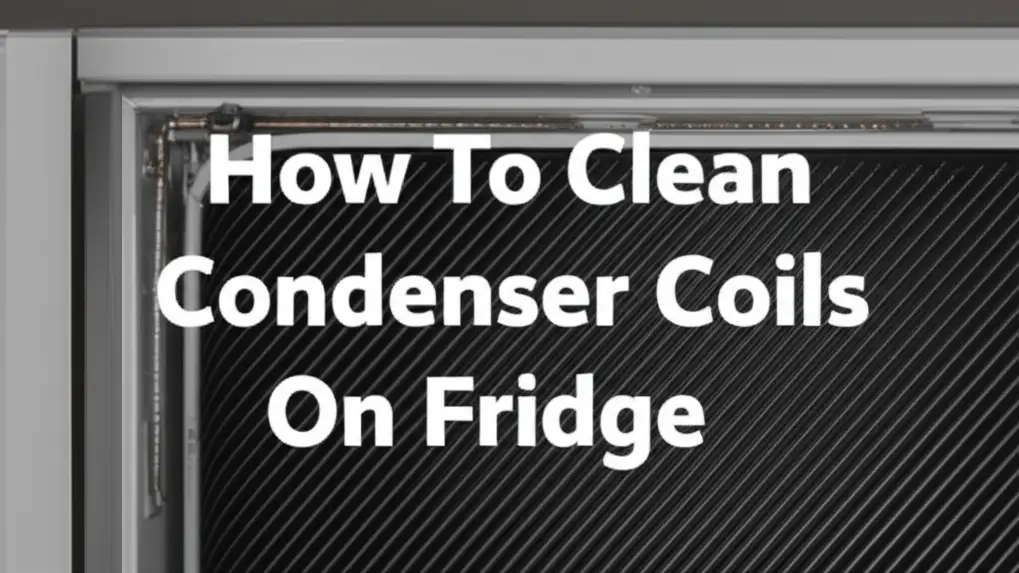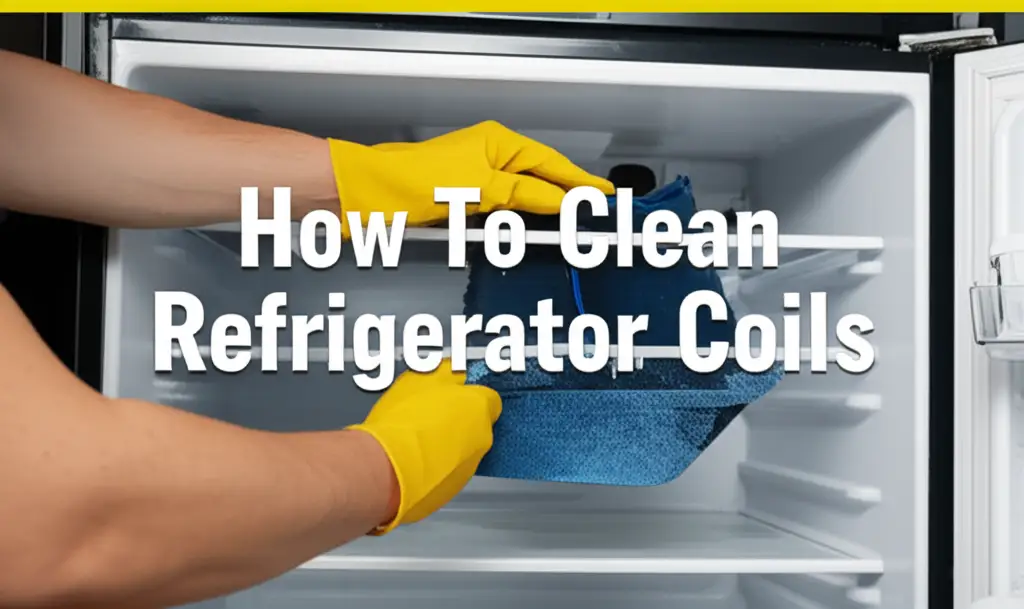· Home Appliances, Maintenance, Cleaning Tips · 17 min read
How To Clean Condenser Coils On Fridge

How to Clean Fridge Condenser Coils for Better Efficiency
Is your fridge working harder than it should? Perhaps it feels warm to the touch, or your groceries are not as cold as you prefer. These are common signs that your refrigerator’s vital parts might need some attention. I understand that cleaning a major appliance can feel like a big task. However, knowing how to clean condenser coils on fridge models is simpler than you think. It is also one of the most impactful maintenance tasks you can do for your refrigerator.
This guide will walk you through the entire process. We will cover why coil cleaning matters, what tools you need, and a step-by-step method to get the job done. You will learn where to find the coils on different fridge types and important safety precautions. By the end, you will feel confident to improve your fridge’s performance and save on energy bills. Let’s make your fridge happy and efficient again.
Takeaway
- Regularly clean your fridge condenser coils to ensure top performance.
- Dust and debris on coils force your fridge to use more energy.
- Cleaning coils extends the life of your refrigerator.
- Gather tools like a vacuum, brush, and screwdriver before you begin.
- Always unplug the fridge before you start any cleaning.
Clear Answer to Main Query
You clean condenser coils on a fridge by first unplugging the unit for safety. Locate the coils at the bottom front or back. Use a vacuum cleaner with a brush attachment to remove dust and debris. A specialized coil brush can dislodge stubborn grime. Finish by wiping away any remaining dirt, then plug your fridge back in.
Why Cleaning Condenser Coils Matters for Your Fridge
You probably do not think about your refrigerator’s condenser coils often. Most people do not. However, these coils are essential for your fridge to work correctly. They help release heat from inside the appliance. When they get dirty, your fridge struggles to cool. This leads to higher energy use and a shorter lifespan for your unit. I learned this the hard way with an old, struggling fridge.
Dust, pet hair, and other debris naturally collect on these coils over time. This layer of dirt acts like a blanket. It traps the heat that should escape. Your fridge’s compressor then works much harder to maintain the set temperature. Think of it like running a marathon in a heavy coat. The compressor gets hot, uses more electricity, and can wear out faster. Cleaning these coils is a quick, easy way to save money and keep your food fresh.
An efficient fridge costs less to run each month. When the coils are clean, heat escapes easily. The compressor does not have to work as hard. This means your energy bill goes down. It also reduces the stress on the appliance’s parts. A well-maintained fridge lasts longer. You avoid expensive repairs or early replacement. Taking a little time now saves you a lot later. This simple task impacts your home budget and the environment.
I always recommend people add this to their regular cleaning schedule. It is a small effort for a big reward. Dirty coils are a leading cause of fridge breakdowns. Preventing these issues helps you avoid unexpected costs and inconvenience. You invest in your appliance’s health when you clean its coils. Your fridge will run quietly and efficiently, keeping your food perfectly cold.
Locating Your Fridge Condenser Coils: A Quick Guide
Before you can clean the condenser coils, you need to find them. The location of condenser coils varies by refrigerator model. Most modern fridges have the coils at the bottom, behind a toe kick plate. Older models often have them on the back of the fridge. Knowing where to look is the first step in successful cleaning.
For many newer refrigerators, you will find the coils underneath. Look at the very bottom front of your fridge. There is usually a removable grille or kick plate. This piece snaps off or unscrews. Once you remove it, you will see a series of black, wire-like coils. They often sit near a fan. This fan pulls air over the coils to help dissipate heat. It can also pull in dust and debris from your kitchen floor.
Some older or side-by-side models have the coils on the back. These coils look like a grid of black pipes. They run vertically or horizontally across the back panel. They are usually exposed, but sometimes covered by a thin cardboard or metal panel. If you have an older fridge, pull it away from the wall to check the back. Make sure to give yourself enough space to work safely.
Knowing the location helps you prepare. If the coils are at the back, you need more room to pull the fridge out. If they are at the front, you might just need a small mat to kneel on. No matter the location, the goal is the same: access the coils to remove accumulated dust. I suggest checking your fridge manual if you are unsure. The manual will show you exactly where your model’s coils are located.
Understanding the coil location prepares you for the cleaning process. You avoid unnecessary steps or confusion. This knowledge ensures you focus your cleaning efforts on the correct area. Soon, your fridge will operate more efficiently thanks to this simple check.
Essential Tools and Safety Steps for Coil Cleaning
Cleaning condenser coils requires only a few basic tools. You likely have most of these items already in your home. Having the right equipment makes the job much easier and more effective. I always gather everything before starting. This prevents interruptions once I begin the cleaning process.
First, you need a vacuum cleaner. A hose attachment with a brush is ideal. This allows you to reach into tight spaces and lift dust effectively. If your vacuum does not have a brush attachment, a crevice tool can work too. Second, a condenser coil brush is very helpful. These brushes are long and thin, designed to reach between the coils and remove stubborn dust. They are inexpensive and can be found at hardware stores or online.
You might also need a screwdriver if your fridge has a cover plate that screws on. A flashlight is useful to see into dark areas under or behind the fridge. Finally, keep some old rags or paper towels handy for wiping away any remaining dust. Some people wear gloves to keep their hands clean, especially if dealing with a lot of dust.
Safety is the most important part of this job. Before you touch any part of your fridge’s coils, always unplug the appliance. This removes any risk of electric shock. Never clean the coils with the fridge plugged in. Also, if you pull the fridge away from the wall, be careful. Fridges are heavy. You do not want to strain your back or damage your flooring. Ask for help if the fridge is too heavy for you to move alone.
Make sure the area around the fridge is clear. Remove any obstacles that could trip you or block your access. Open a window or use a fan if the area is dusty. This helps keep the air clean as you work. Taking these simple safety steps ensures a smooth and secure cleaning experience. I always tell my friends to prioritize safety above all else.
Step-by-Step Guide: How to Clean Condenser Coils on Fridge
Now that you know where your coils are and have your tools, it is time to clean them. This process is straightforward. Following these steps will ensure you do a thorough job. I use this method myself, and it always works well.
Step 1: Unplug the Refrigerator. This is the most critical step for safety. Pull the power cord from the wall outlet. Do not just turn off the fridge; actually unplug it. This prevents any accidental starts during cleaning. You should never work on an appliance while it is connected to power.
Step 2: Gain Access to the Coils. If your coils are at the bottom front, gently pull off the toe kick plate. It usually snaps off. Some models might have screws; use a screwdriver if needed. If your coils are at the back, carefully pull the fridge away from the wall. Give yourself enough room to work comfortably. For models with a back panel, you might need to unscrew it.
Step 3: Vacuum the Coils. Use your vacuum cleaner with a brush attachment. Carefully vacuum the entire coil area. Go slowly to pick up all the loose dust, dirt, and pet hair. Pay attention to the fan blades if they are visible near the coils. They also collect dust. The vacuum removes the majority of the buildup.
Step 4: Use a Coil Brush for Stubborn Grime. After vacuuming, use a condenser coil brush. Insert the brush between the coils. Gently push and pull it to dislodge any stuck-on dust or debris. This brush reaches deeper than the vacuum. Work from top to bottom if the coils are vertical. For horizontal coils, work across each one. Be gentle to avoid bending the coils.
Step 5: Vacuum Again. Once you have loosened all the grime with the brush, vacuum the area one more time. This ensures you collect all the dislodged particles. Make sure the area looks visibly clean. You want to see the bare metal of the coils. This second vacuuming is important for a complete clean.
Step 6: Replace Covers and Push Fridge Back. Once the coils are clean, put the toe kick plate back on. If you removed a back panel, screw it back in place. Carefully push your refrigerator back into its original position. Ensure it sits level and stable. Do not push it against the wall too tightly. Allow some airflow.
Step 7: Plug the Refrigerator Back In. Finally, plug the power cord back into the wall outlet. Your fridge will start running. It might take a few hours for the temperature inside to fully stabilize. You will likely notice a quieter running sound and more efficient cooling. This simple process makes a big difference.
Handling Specific Fridge Configurations: Top vs. Bottom Coils
While the general steps for cleaning condenser coils remain similar, accessing them can differ based on your refrigerator’s design. Knowing if your coils are on the top, bottom, or back helps tailor your approach. Most modern fridges have bottom-mounted coils, but some designs still feature coils elsewhere. I make sure to check my specific model before I start.
Bottom-Mounted Coils
Many contemporary refrigerators, especially French door and bottom-freezer models, have their condenser coils located at the bottom. These coils are typically behind a snap-on or screw-on grille or kick plate, positioned at the very front base of the fridge. Accessing them is usually quite straightforward. You just need to remove this front panel. Sometimes, the coils are further back, requiring you to slide the fridge out a few inches. Once the panel is off, you will see the coils and often a small fan. This fan helps move air over the coils for efficient cooling. Focus your vacuuming and brushing efforts on this area, making sure to clean the fan blades as well.
Back-Mounted Coils
Older refrigerators, including many top-freezer and some side-by-side models, have their condenser coils mounted on the back. These are usually visible as a large, black grid of pipes. To clean these, you must pull the entire refrigerator away from the wall. You need enough space to safely access the back panel. Some units might have a thin cardboard or metal cover over the coils that you need to remove. This often involves unscrewing a few fasteners. Once exposed, you can vacuum and brush the coils from top to bottom. Be careful not to bend any of the delicate fins on the coils. Ensuring proper airflow around these coils after cleaning means leaving a few inches of space between the fridge and the wall.
Top-Mounted Coils (Rare)
While less common for home refrigerators, some commercial or specialized units might have condenser coils located on the top. Accessing these often requires removing a top panel or grille. If your fridge manual indicates top-mounted coils, carefully follow the instructions for panel removal. Cleaning procedures remain the same: vacuum thoroughly, use a coil brush for stubborn dirt, and then re-vacuum. Always prioritize safety by unplugging the unit, regardless of where the coils are located.
Understanding your fridge’s specific configuration makes the cleaning process easier and more efficient. It ensures you target the correct area and use the most effective access method. A little preparation goes a long way in keeping your appliance running well. You can even check out how cleaning coils works on other appliances like an AC unit to get more ideas.
Beyond Basic Cleaning: Tips for Maintaining Coil Health
Cleaning your condenser coils is not a one-time event. It is an ongoing maintenance task that keeps your fridge running well. Understanding how often to clean and what else affects coil health helps extend your appliance’s life. I always recommend proactive care.
How Often to Clean
The frequency of cleaning depends on your home environment. For most households, cleaning condenser coils once every 6 to 12 months is sufficient. If you have pets that shed a lot of hair, or if your kitchen gets very dusty, you might need to clean them more often, perhaps every three months. Pet hair is particularly notorious for clogging coils quickly. I find a visual check every few months is a good idea. If you see visible dust buildup, it is time to clean. This quick check helps prevent major accumulation.
What to Avoid
When cleaning, avoid using water or harsh chemicals directly on the coils. Water can cause rust and electrical shorts. Harsh chemicals might damage the delicate fins or the coating on the coils. A dry vacuum and a coil brush are the safest and most effective tools. Do not bend the coil fins. They are designed to dissipate heat. Bending them reduces their efficiency. If you accidentally bend a fin, you can gently straighten it with a thin, flat tool, like a butter knife, but avoid doing so if possible.
Optimizing Fridge Placement
Where your fridge sits in your kitchen also affects coil health. Make sure your refrigerator has enough space around it for proper air circulation. If the coils are at the back, leave a few inches between the fridge and the wall. This allows heat to escape properly. If the coils are at the bottom, ensure the toe kick grille is not blocked by rugs or debris. Good airflow means less work for your compressor and less dust settling on the coils.
Consider the ambient temperature of your kitchen. Placing a fridge in a very hot area, like direct sunlight or next to an oven, makes it work harder. This increases heat production and can lead to faster coil buildup. A cooler location helps your fridge run more efficiently overall. Keeping your coils clean, avoiding harmful cleaning agents, and ensuring good airflow contribute greatly to your fridge’s longevity and energy efficiency. These simple habits save you money and headaches in the long run.
Recognizing Signs Your Condenser Coils Need Cleaning
Your refrigerator often gives subtle hints when its condenser coils are dirty. Paying attention to these signs can help you address the issue before it leads to bigger problems. I learned to spot these warnings, and it has saved me from fridge troubles.
One of the most common signs is your fridge running more often or for longer periods. If you notice the compressor cycling on and off more frequently, or if it seems to run almost constantly, dirty coils are a likely culprit. The fridge struggles to reach and maintain the set temperature because it cannot release heat efficiently. This constant running puts strain on the compressor and wastes energy. It is a clear signal that the coils need attention.
Another tell-tale sign is the refrigerator feeling warm to the touch. Specifically, the sides or back of the fridge might feel unusually warm. The coils release heat. If they are covered in dust, the heat gets trapped inside the unit. This warmth indicates the fridge is working overtime to shed heat. If your fridge feels hotter than normal, check the coils.
You might also notice that your food is not staying as cold as it should. Milk might spoil faster, or ice cream might feel softer than usual. The fridge struggles to keep internal temperatures low when the coils are dirty. This can lead to food spoilage and health risks. An inconsistent temperature inside is a strong indicator of a cooling problem, often linked to coil performance.
An increase in your energy bill without changes in usage can also point to dirty coils. Since the compressor works harder, it consumes more electricity. If your electricity costs rise unexpectedly, it is worth checking the fridge coils. They are a common cause of increased energy consumption. Dirty coils are a hidden drain on your wallet.
Finally, visible dust and grime on the coils themselves are the most obvious sign. If you pull off the kick plate or move the fridge and see a thick layer of fuzz on the coils, they definitely need cleaning. Do not wait for other symptoms if you see the dust. Just clean them right away. Recognizing these signs helps you maintain your fridge proactively and avoid costly repairs down the line.
FAQ Section
How often should I clean my fridge’s condenser coils?
You should clean your fridge’s condenser coils at least once every 6 to 12 months. If you have pets that shed a lot or if your home collects a lot of dust, consider cleaning them every three to six months. Regular cleaning keeps your fridge running efficiently and helps it last longer.
What happens if I don’t clean my condenser coils?
If you do not clean your condenser coils, dust and debris will build up. This buildup prevents the coils from releasing heat effectively. Your refrigerator’s compressor will work harder and run longer to keep food cold. This leads to higher energy bills, reduced cooling performance, and can shorten the lifespan of your fridge.
Can I use water to clean condenser coils?
No, you should avoid using water or wet cloths directly on condenser coils. Water can cause rust and create an electrical hazard when the fridge is plugged back in. Always use dry methods like a vacuum cleaner with a brush attachment or a specialized coil brush for cleaning.
Where are condenser coils typically located on a refrigerator?
Condenser coils are usually located at the bottom front of newer refrigerators, behind a removable toe kick plate or grille. On older models, they are often found on the back of the appliance, as a visible grid of black pipes. Always check your fridge manual if you are unsure.
Is it safe to clean the coils myself, or should I hire a professional?
Cleaning condenser coils is a simple and safe DIY task for most people. Just remember to always unplug the refrigerator before you start. If you are uncomfortable moving your fridge, or if you notice complex issues, then hiring a professional appliance technician is a good idea.
What tools do I need for cleaning fridge coils?
You need a vacuum cleaner with a brush or crevice attachment to remove loose dust. A specialized long, thin condenser coil brush is also very helpful for reaching between the coils and dislodging stubborn dirt. A flashlight and a screwdriver might also be useful for access.
Conclusion
Taking the time to clean your refrigerator’s condenser coils is a simple yet impactful maintenance task. We have covered why this job is so important, from boosting energy efficiency to extending your fridge’s lifespan. You now know where to find the coils on various models and have a clear, step-by-step guide on how to clean condenser coils on fridge safely and effectively. Remember, regular cleaning prevents common fridge problems like poor cooling and high energy bills.
By making this a routine part of your home maintenance, you are investing in your appliance’s health. You will notice your fridge runs quieter, keeps food colder, and costs less to operate. This is one of those small efforts that yields big rewards. I encourage you to add condenser coil cleaning to your seasonal cleaning checklist. Your fridge will thank you with reliable, efficient performance for years to come.
- fridge maintenance
- condenser coils
- appliance cleaning
- energy efficiency
- DIY cleaning




